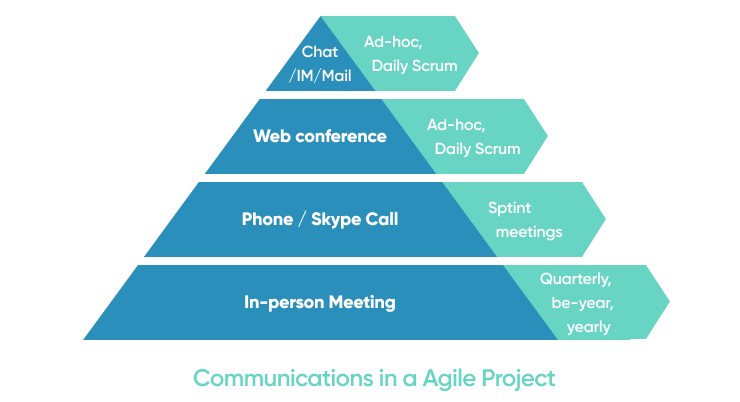The world is considered a global village and, due to this, there is greater access to the best talent to hire for software development project and related products and services. Cost-effectiveness, better human resources, and improved business results are important reasons why software development projects are outsourced to software development companies.
Though outsource software development is an advantageous business arrangement, it comes with its own challenges. It is worth considering them before deciding to choose an outsourcing partner who will be working on your project hands-on. Listed below are 12 noteworthy challenges that are worth mentioning to help you make wise choices for software solutions.
- 1. Finding a Software Development Partner You Trust
- 2. Working in different time zones
- 3. Insufficient or poor communication
- 4. Lack of experience with remote teams
- 5. Project estimation accuracy
- 6. Budget savings without sacrificing the quality
- 7. Lack of control over the process and management
- 8. Quality of outsourcing provider services
- 9. Delays caused by provider lacking resources
- 10. Key people dropping out of the project
- 11. Data security and IP protection
- 12. End product that does not leave up to expectations
- Conclusion
Finding a Software Development Partner You Trust
A trusted partner for software development means they not only have the expertise and skills required to complete a project but also take a keen interest in the needs and requirements of your company to provide solutions that can generate value in an apt sense.
There are numerous software outsourcing companies that offer software solutions, and the way that you make the choice of a partner is by knowing if they are trustworthy according to your needs and not just what the outsourced developers may offer from their own understanding of your organization.
Solution

Before beginning the project, software developers take as much information as possible from you to provide IT solutions. By having a level of trust, the software development partner takes a keen interest in understanding your company, the industry, and your intent for the software solution and brings out all plausible solutions that match your customers' needs. In essence, they take ownership of the project, and it is challenging to find such a partner.
Read more: How to Find Software Development Partners - Steps-by-Step Guide
Working in different time zones
It is not easy to work with software developers in different time zones. And this is even more challenging when the time overlap is wider. For instance, the time overlap between partners in US and India is around 12 hours. Though it looks like the project is being developed 24 hours a day due to the time zones, it also poses technical and communication glitches. The number of productive working hours between the resource partners of both companies would be considerably lower. Which will make the whole outsourcing process longer. In comparison to a development partner in a continent where the time zone overlap is wider, offshore partners with smaller time zone gaps are much more resourceful for productive day-to-day workability.
Solutions
- Choose your partner who is in the time zone of a smaller overlapping of times.
- Maintain Good Communication: This ensures the quality of output is not compromised and the work is done as per planned schedules.
- Create Inclusiveness: Despite the time zone variation and fewer face-to-face connections, maintain inclusiveness as a team so that resource productivity and efficiency are high.
- Create smaller teams and delegate work.
Insufficient or poor communication
A recent study showed that nearly 90% of businesses believed communication to be one of the key challenges with outsourcing capabilities. This can arise from a number of factors, such as culture (both national and organizational), language, and the distributed nature of teams.
This can be further compounded by the client/service provider dynamic, where service vendor staff might feel compelled to be agreeable towards the client and not challenge unachievable requests, ultimately leading to disappointment when results do not materialize.
Solutions
- Ensure that the outsourced team members have a good command of English, using an established standard such as the Common European Framework of Reference (CEFR), and ensure that your outsourcing contract states the appropriate minimum standard you require for any new resource.
- Make sure that those leading your meetings have excellent facilitation skills, checking for understanding and asking attendees to confirm their alignment.
- Make use of face-to-face or video calls as a lot of communication can be non-verbal.
- Make sure that working patterns across time zones are agreed upon. If there is a significant time zone difference this can impact collaboration.

Lack of experience with remote teams
We're in an era where working remotely is becoming increasingly common. Many businesses, in fact, are totally remote. Remote teams allow companies to tap into a larger talent pool and allow everyone to work where and how they are most productive.
Solutions
- Clearly state the project's success definition. Probably the most important aspect is both parties are aligned on what success looks like. If it’s at all unclear what you want to achieve at the end, rewrite it.
- Show the top-level user journey walkthrough. This urges the offshore team to adopt a more user-centric approach and better relate sprints/milestone deliverables to the big picture.
- Over Communicate. Assign someone in-house to ensure that the offshore team gets all the info they could possibly need. This person's role would be to keep an eye on any changes to the software project and communicate to the offshore team.
Read more: Managing Remote Engineering Teams — Best Practices & Tools
Project estimation accuracy
Project estimation is tricky, and especially when they are larger software projects, even a minor deviation from the actual plan may incur huge costs. To avoid surprises in cost budgeting and mishaps, the following factors need to be under check.
Solutions
Clarity of software project requirements: Make a list of all functional requirements that you are looking forward to developing. Invest time in the same as it will save a lot of time and money investment at the later stages of software development. Prepare a spreadsheet with all the requirements and to-do’s and make detailed cost estimates for your understanding based on your budget and experience so that you can get an accurate quote that can be negotiated if needed. You will have the readiness and knowledge to understand the outsourcing partner much better.
Avoid fixed-price projects: These are estimates that are made based on the waterfall process with fixed pricing. This does not allow you to make changes when needed and will not give you the flexibility to assess the quality of the work done until the project is completed. The money investment is fixed and has to be paid in full irrespective of the quality of the output. Any changes will attract further costs and increase the software budget manifold.
Create ball mark estimates: This has Agile flexibility. The project is planned and categorized in different stages of development and the price estimation is prepared for each stage. This creates accountability to have a quality output and also make changes without incurring huge costs. Even if a risk has occurred and the project is scrapped after the first stage of development, the company will not lose more than one-third of the project cost.
Budget savings without sacrificing the quality
When we discuss cost versus quality, you need to consider both as equally important but never compromise the quality of the software due to cost considerations. Higher quality almost always comes with an equally valuable price tag.
Solutions
Price is not the key priority: Choose an outsourcing partner not based on the quote they offer but on the quality of the software they develop. Their track record speaks volumes about their work, the talent pool of resources, their ability to complete the software projects on time, and flexibility in their offerings. It is never a wise idea if cost is the main factor in deciding on an outsourcing development partner.
Hire skilled project managers: An in-house project manager saves time and efficiency and can be the voice of the outsourcing partner to manage the project as per the initial expectations and planning. A skilled project manager who can work along with the skilled project team of the outsourced company can form a great combination of efficiency and insight.
Look for offshoring opportunities: Skilled team members can be found in other countries, and they have a better hourly rate according to their country. Always choose skill and quality over cost when hiring human resources.
Lack of control over the process and management
As a business leader, it may feel uncomfortable and alien to be handing over vast swathes of the infrastructure management and processes of your organization to another outsourcing company, and indeed, this perceived loss of control can be disconcerting. Critics of IT outsourcing argue that no external supplier can match an in-house team's responsiveness and service levels, partly because the vendor is not subject to the same managerial direction and control as your workforce. Of course, the lack of control itself is not a risk, but rather what may arise as a result.
Solutions
Transparency will be required between your organization and outsourcing firms regarding which elements of the management structure you will be required to retain control of. A “RACI” document showing responsible/accountability/consulted/informed can help here.
Focus on outcomes and metrics, whether this is throughput, customer experience, or something else. Allowing the outsourcer to focus on results can provide some leeway in terms of how those results are achieved.
Determine a communication cadence. Often, regular reports can be a good way for the outsourcer to provide periodic updates to the client.
Quality of outsourcing provider services
Outsourced services' poor quality standards are both a nightmare and one of the most common risks of outsourcing. For the cost savings, companies choose outsourcing companies with the most favorable price, overlooking the reason for such a low cost of services.
Poor eed to look beyond the price and learn more about the development partner to understand its true value for you.
Solutions
- Ask the outsourcing company for examples of previous work. See who they have worked with previously and what type of jobs they have done. This serves a number of purposes.
- Make sure your outsourcing partner uses project management methodology and DevOps practices.
- Establish clear expectations with Service Level Agreement (SLA) that lists services provided by the outsourcing firm and their costs.
- Find or hire someone on your a who can inspect the work of the remote team: a tech-savvy specialist on your side will be an additional guarantee of high quality of the finished product code and will help to avoid this and other risks of outsourcing associated with technical challenges.
Delays caused by provider lacking resources
Risks are factor providers lack entirely avoidable but can be mitigated through proper planning and follow through with the implementation till the end of the project. Irrespective of having done the best in planning challenges do come and most importantly through the outsourced partner. Lack of resources on their part cannot be solved by you. It sometimes becomes tricky when you can neither leave the outsourced partner because they lack resources nor can we hire on their behalf. This is one of the primal reasons why to choose a trusted partner who takes an active interest in delivering the said promise through ownership and commitment. And they usually come at a higher cost and that is good.
This is a challenge when the outsourced partner has done improper planning of his budgeting and it sometimes reaches a point of renegotiation of pricing to ensure the project does not end in a stalemate. All the planning is avoided by choosing a trust importantly,
Key people dropping out of the project
People dropping out of the project is not a concern of the outsourcing company as the resources can always be hired again. The challenge is when the resource partner is unable to recruit within a specific timeline and the project is being delayed due to a lack of skilled manpower. It is the duty of the outsourced partner to adhere to the initial agreement between the two partners on their roles and responsibilities. If the outsourced partner happens to backtrack on the commitments due to various reasons there are legal recourses that come into The outsourcing company can choose another partner, but that is again starting from scratch and there is a risk of delay in project completion.
Solutions
- Hire people for the project who have a good track record: There are many people who switch companies very often and are never reliable enough to stay on a project for long. If you are looking for people who have to stay committed for a long time, pay well and look for attributes that show stability in their job commitments.
- Pay On Par With The Industry: A good resource produces a quality outcome. Pay well to keep the key people, as they are the ones who handle many others who are required on the project.
- Do a thorough background check: Background checks and verifications are important for key positions. Resumes can be faked, but not the attributes and skills that they can bring along.
- Have your own project manager/managers: There can be more than one project manager. Hire your own in-house project manager who oversees the outsourced partner resources.
Data security and IP protection
In the outsourcing model, you need to be aware of this risk and implement all measures necessary to avoid damages that may result from the potential violations of data security and/or intellectual property rights when outsourcing services.
Share sensitive information and personal or vital data about your IT systems can result in decreased security. Keeping your data secure when using a service provider requires a multi-pronged approach and regular risk assessment. It’s important to address these separately as you evaluate a service provider.
Data security is often weighting in the outsourcing decision. You should hold the outsourcing firms accountable for any risk that may come from outsourcing. Outsource to a partner who knows how to handle security and implements contingency plans to mitigate risks.
Solutions
- Before hiring an outsourcing company, or after hiring a vendor but before sharing any confidential information, you should enter into a non-disclosure agreement (NDA) with the vendor (following your local IP laws).
- Conduct due diligence on independent review platforms before entering into an agreement with the vendor. The scope of such due diligence should include the vendor’s reputation and any past breaches of its clients’ intellectual property rights. You should also investigate the vendor’s internal risk measures, their ability to safeguard your IP, and what its response would be to a data breach within their organization.
- Check our Custom Software Development Contract Template Checklist
End product that does not leave up to expectations
The end output is always the quality of the input given from the beginning in all areas and stages of software development. The challenges that may have affected the end output may be improper planning from the start, lack of clarity of goals and intent of the project, poor or inadequate communication, lack of skilled resources, and weighing cost over quality, to name a few. Now that the software product is already developed, the only thing left is to test its workability to the maximum and tweak changes to make it more workable.
Solutions
- Test the software thoroughly.
- Let the resource partner test the same and come up with plausible recommendations and changes.
- Do manual testing and share it with the development team to initiate changes.
- Test the software with internal systems to avoid incompatibility and performance issues.
- Initiate Code review culture. Human errors do occur, and with good communication, we can share how to initiate changes with the outsourced partners.
- Document the work that has been done in-house and shares it with the resource partners to create checks
- Keep a document of the work done by the resource partners; this comes in handy to where and from whom to initiate changes in the future.
Conclusion
The market size of software development projects is close to 100 billion dollars and has proven to be a profitable arrangement for both the company and the resource partner. The last two decades have seen a spike in the growth of the offshore software development outsourcing industry, and it has undergone much fine-tuning where credible and creditable resource partners are available to serve the demand from overseas clients.
Recruiting a team of developers, paying competitive salaries, and managing the team for a single project does not make sense for an organization because it involves huge costs. Outsourcing software development offers leverage where time, effort, and costs are reduced significantly. With the help of a software development company, you are able to create a software development team and plan the whole software development process.
While pursuing any endeavor, challenges are a must and so are the prospect of software outsourcing projects. The listed challenges and solutions will give a direction of thought while venturing into a project that may not be done in-house. From all of the above pointers, the most simple and reasonable one, to begin with, is choosing trustworthy partners over cost-effective ones. It is choosing quality over cost. It is choosing to communicate better than leaving the task to the resource partner entirely. Through proper checks and balances and maintaining a system of alignment and effective communication, outsourcing is good leverage while mitigating risks through effective planning at every stage of development from the very beginning.

